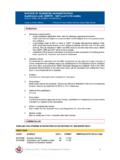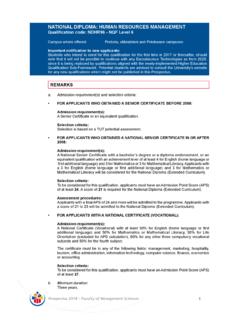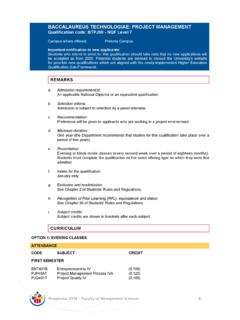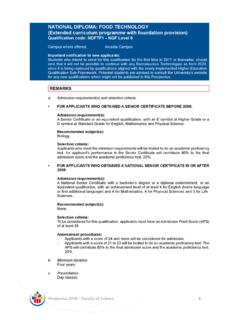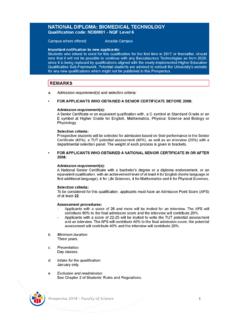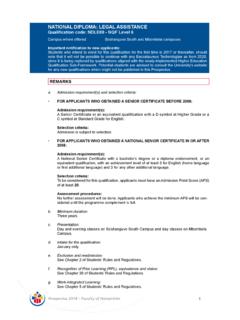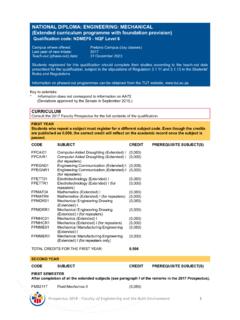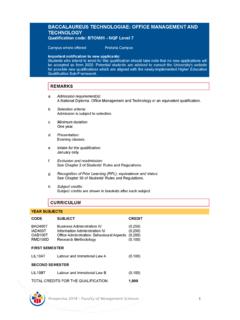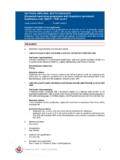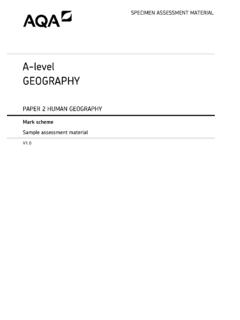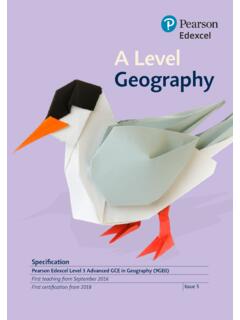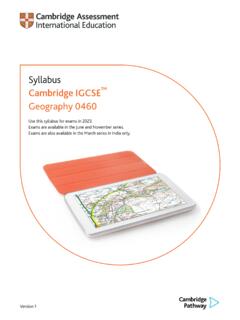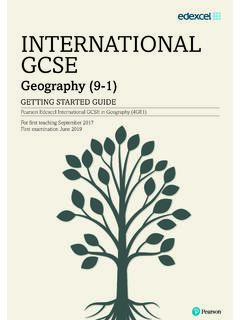Transcription of DIPLOMA IN ENVIRONMENTAL SCIENCES Dip (Environmental ...
1 DIPLOMA IN ENVIRONMENTAL SCIENCES . Dip ( ENVIRONMENTAL SCIENCES ) - NQF Level 6 (360 credits). Qualification code: DPEV19. SAQA ID: 100981, CHE NUMBER: H16/14271/HEQSF. Campus where offered: Arcadia Campus REMARKS. a. Admission requirement(s) and selection criteria: Acceptance is subject to available capacity according to the Student Enrolment Plan (SEP). Once a programme is full, a waiting list will be in place to provide an opportunity for applicants to fill places of those who did not register on time. Applicants will be informed of their status per official letter from the Office of the Registrar, alternatively, they can check their application status on the TUT website, APPLICANTS WITH A SENIOR CERTIFICATE OBTAINED BEFORE 2008: Admission requirement(s): A Senior Certificate or an equivalent qualification, with a D symbol at Standard Grade or an E symbol at Higher Grade for English, Mathematics and Physical Science.
2 Recommended subject(s): Biology and Geography. Selection criteria: For 2022: Applicants who meet the minimum requirements will be considered for admission. As from 2023: Applicants who meet the minimum requirements will be invited to do an acade- mic proficiency test. The applicants' performance in the Senior Certificate will contribute 80%. to the final admission score and the academic proficiency test 20%. Applicants who pass the proficiency test will be shortlisted for selection by a departmental selection panel. APPLICANTS WITH A NATIONAL SENIOR CERTIFICATE OBTAINED IN OR AFTER 2008: Admission requirement(s): A National Senior Certificate with a bachelor's degree or a DIPLOMA endorsement, or an equivalent qualification, with an achievement level of at least 4 for English (home language or first additional language), 4 for Mathematics or Technical Mathematics and 4 for Physical SCIENCES or Technical SCIENCES .
3 Recommended subject(s): Geography and Life SCIENCES . Selection criteria: To be considered for this qualification, applicants must have an Admission Point Score (APS). of at least 21 (excluding Life Orientation). Assessment procedure(s): For 2022: Applicants who meet the minimum requirements will be considered for admission. As from 2023: Applicants with a score of 24 and more will be considered for admission. Applicants with a score of 21 to 23 will be invited to do an academic proficiency test. The APS will contribute 80% to the final admission score and the academic proficiency test, will contribute 20%. c. Recognition of Prior Learning (RPL), equivalence and status: See Chapter 30 of Students' Rules and Regulations.
4 1 Faculty of Science d. Intake for the qualification: January only. e. Presentation: Day classes. f. Minimum duration: Three years. g. Exclusion and readmission: See Chapter 2 of Students' Rules and Regulations. h. WIL in ENVIRONMENTAL SCIENCES I: See Chapter 5 of Students' Rules and Regulations. CURRICULUM. FIRST YEAR. CODE MODULE NQF-L CREDIT PREREQUISITE MODULE(S). 11P105X Communication for Academic (5) (10). Purposes CPL105X Computer Literacy (5) (10). GCH105D General Chemistry I (5) (24). GMA105D General Mathematics I (5) (24). GPH105D General Physics I (5) (24). INI125D Information Literacy I (5) (2). (block module). LFI125X Life Skills I (block module) (5) (2).
5 FIRST SEMESTER. AEP115D Applied ENVIRONMENTAL Practice I (5) (6). EVB115D ENVIRONMENTAL Biology I (5) (6). SECOND SEMESTER. EVE115D ENVIRONMENTAL Earth Studies I (5) (6). EVM115D ENVIRONMENTAL Management I (5) (6). TOTAL CREDITS FOR THE FIRST YEAR: 120. SECOND YEAR. CODE MODULE NQF-L CREDIT PREREQUISITE MODULE(S). AEP206D Applied ENVIRONMENTAL Practice II (6) (20) Applied ENVIRONMENTAL Practice I. ELP206D ENVIRONMENTAL Legal Practice II (6) (20). EPS206D ENVIRONMENTAL Pollution (6) (20) General Chemistry I. Science II. EVB206D ENVIRONMENTAL Biology II (6) (20) ENVIRONMENTAL Biology I. EVE206D ENVIRONMENTAL Earth Studies II (6) (20) ENVIRONMENTAL Earth Studies I.
6 EVM206D ENVIRONMENTAL Management II (6) (20) ENVIRONMENTAL Management I. TOTAL CREDITS FOR THE SECOND YEAR: 120. 2 Faculty of Science THIRD YEAR. CODE MODULE NQF-L CREDIT PREREQUISITE MODULE(S). FIRST SEMESTER. AEP316D Applied ENVIRONMENTAL Practice III (6) (15) Applied ENVIRONMENTAL Practice II. EPS316D ENVIRONMENTAL Pollution (6) (15) ENVIRONMENTAL Pollution Science II. Science III. EVB316D ENVIRONMENTAL Biology III (6) (15) ENVIRONMENTAL Biology II. EVM316D ENVIRONMENTAL Management III (6) (15) ENVIRONMENTAL Management II. SECOND SEMESTER. On completion of all modules. WES316D WIL in ENVIRONMENTAL SCIENCES I (6) (60). TOTAL CREDITS FOR THE THIRD YEAR: 120.
7 TOTAL CREDITS FOR THE QUALIFICATION: 360. MODULE INFORMATION (OVERVIEW OF SYLLABUS). The syllabus content is subject to change to accommodate industry changes. Please note that a more de- tailed syllabus is available at the Department or in the study guide that is applicable to a particular module. At time of publication, the syllabus content was defined as follows: A. APPLIED ENVIRONMENTAL PRACTICE I (AEP115D) CONTINUOUS ASSESSMENT. (Module custodian: Department of ENVIRONMENTAL , Water and Earth SCIENCES ). Essay writing. Site visit. Mapping and geographical positioning system. (Total notional time: 60 hours). APPLIED ENVIRONMENTAL PRACTICE II (AEP206D) CONTINUOUS ASSESSMENT.
8 (Module custodian: Department of ENVIRONMENTAL , Water and Earth SCIENCES ). Scientific report writing. Learn to select appropriate tools and techniques in creating or editing graphics within a guided environment. Demonstrate detailed knowledge of and the ability to use the key terms, concepts, facts, principles, theories of how remote sensing works. Distinguish between possible areas of specialisation within the field of remote sensing and understand how remote sensing can be used in ENVIRONMENTAL monitoring and geographical information systems (GIS). Detailed knowledge and the ability to apply key terms, concepts, facts, principles, rules and theories in the field of geographical information systems and an understanding of how it is related to other closely related fields like geology, town planning, botany, hydrology and climatology.
9 Evaluate a geospatial problem, select and apply appropriate geographic information system (GIS) methods, procedures and techniques to identify and apply geospatial analysis. Demonstrate the ability to identify, analyse and solve problems in unfamiliar contexts like a site visit to a greenfields or brownfields site where a development is proposed to occur, gathering relevant evidence of the current biotic and abiotic ENVIRONMENTAL conditions and applying baseline assessment procedures to make informed recommendations on how the development should be managed. (Total notional time: 200 hours). APPLIED ENVIRONMENTAL PRACTICE III (AEP316D) CONTINUOUS ASSESSMENT.
10 (Module custodian: Department of ENVIRONMENTAL , Water and Earth SCIENCES ). Air dispersion modelling. Demonstrate detailed knowledge of Geographic Information Systems (GIS) and the ability to apply its key terms, concepts, facts, principles, rules and theories. Use Geographic Information Sys- tems (GIS) for the investigation of ENVIRONMENTAL problems with a view to finding appropriate solutions to those problems. Identify, analyse and solve problems with new unfamiliar developments or projects, gathering evi- dence and applying solutions based on evidence and procedures appropriate to the field of ENVIRONMENTAL Im- pact Assessment (EIA) or Strategic ENVIRONMENTAL Assessment (SEA) in ENVIRONMENTAL science.
